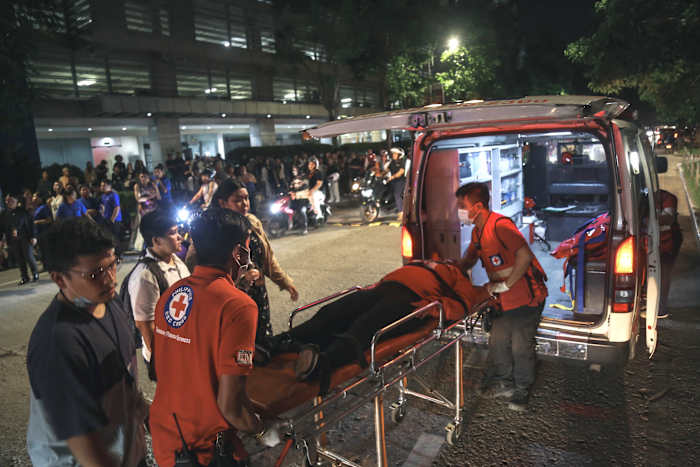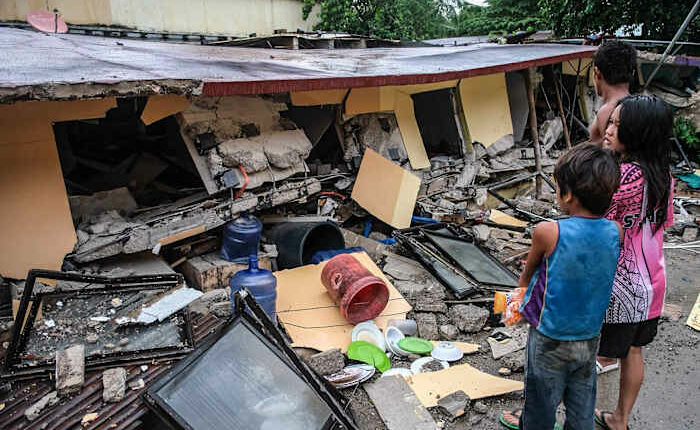Share this @internewscast.com

MANILA – At least 69 individuals lost their lives following a strong earthquake that struck a central province in the Philippines, where many fatalities were reported due to the tremor on Tuesday night.
The earthquake, registering a magnitude of 6.9, occurred around 10 p.m., entrapping an unknown number of residents within collapsed buildings, bars, and other establishments in the severely affected city of Bogo and surrounding rural areas in Cebu province, according to officials.
Rescue teams worked urgently on Wednesday to locate survivors. Aided by backhoes and sniffer dogs, army units, police forces, and civilian volunteers were mobilized to conduct thorough searches from house to house for those trapped.
The quake’s epicenter, triggered by movement along an undersea fault line at a perilously shallow depth of 5 kilometers (3 miles), was situated approximately 19 kilometers (12 miles) northeast of Bogo, a coastal city housing about 90,000 residents in Cebu province, where nearly half of the casualties were reported, said officials.
With the death count in Bogo anticipated to increase, authorities cited ongoing rain and damaged infrastructure like bridges and roads as significant obstacles in the rescue efforts.
“We’re still within the critical period for search and rescue,” stated Office of Civil Defense deputy administrator Bernardo Rafaelito Alejandro IV during a news conference. “Numerous reports are coming in of individuals trapped or struck by rubble.”
The Philippine government is considering whether to seek help from foreign governments based on an ongoing rapid damage assessment, Alejandro said.
Workers were trying to transport a backhoe to hasten search and rescue efforts in a cluster of shanties in a mountain village hit by a landslide and boulders, Bogo city disaster-mitigation officer Rex Ygot told The Associated Press early Wednesday.
“It’s hard to move in the area because there are hazards,” said Glenn Ursal, another disaster-mitigation officer, who added that some survivors were brought to a hospital from the mountain village.
Deaths also were reported from the outlying towns of Medellin and San Remigio, where three coast guard personnel, a firefighter and a child were killed separately by collapsing walls and falling debris while trying to flee to safety from a basketball game in a sports complex that was disrupted by the quake, town officials said.
The earthquake was one of the most powerful to batter the central region in more than a decade and it struck while many people slept or were at home.
The Philippine Institute of Volcanology and Seismology briefly issued a tsunami warning and advised people to stay away from the coastlines of Cebu and the nearby provinces of Leyte and Biliran due to possible waves of up to 1 meter (3 feet).
No such waves were reported and the tsunami warning was lifted more than three hours later, but thousands of traumatized residents refused to return home and chose to stay in open grassy fields and parks overnight despite intermittent rains.
Cebu and other provinces were still recovering from a tropical storm that battered the central region on Friday, leaving at least 27 people dead mostly due to drownings and falling trees, knocking out power in entire cities and towns and forcing the evacuation of tens of thousands of people.
Schools and government offices were closed in the quake-hit cities and towns while the safety of buildings were checked. More than 600 aftershocks have been detected after Tuesday night’s temblor, Philippine Institute of Volcanology and Seismology director Teresito Bacolcol said.
Rain-soaked mountainsides were more susceptible to land- and mudslides in a major earthquake, he warned.
“This was really traumatic to people. They’ve been lashed by a storm then jolted by an earthquake,” Bacolcol said. “I don’t want to experience what they’ve gone through.”
The Philippines, one of the world’s most disaster-prone countries, is often hit by earthquakes and volcanic eruptions due to its location on the Pacific “Ring of Fire,” an arc of seismic faults around the ocean. The archipelago is also lashed by about 20 typhoons and storms each year.
Copyright 2025 The Associated Press. All rights reserved. This material may not be published, broadcast, rewritten or redistributed without permission.












